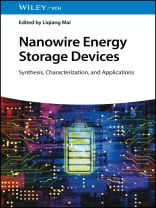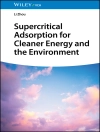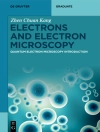Nanowire Energy Storage Devices
Comprehensive resource providing in-depth knowledge about nanowire-based energy storage technologies
Nanowire Energy Storage Devices focuses on the energy storage applications of nanowires, covering the synthesis and principles of nanowire electrode materials and their characterization, and performance control. Major parts of the book are devoted to the applications of nanowire-based ion batteries, high energy batteries, supercapacitors, micro-nano energy storage devices, and flexible energy storage devices. The book also addresses global energy challenges by explaining how nanowires allow for the design and fabrication of devices that provide sustainable energy generation.
With contributions from the founders of the field of nanowire technology, Nanowire Energy Storage Devices covers topics such as:
- Physical and chemical properties, thermodynamics, and kinetics of nanowires, and basic performance parameters of nanowire-based electrochemical energy storage devices
- Conventional, porous, hierarchical, heterogeneous, and hollow nanomaterials, and in-situ electron microscopic and spectroscopy characterization
- Electrochemistry, advantages, and issues of lithium-ion batteries, unique characteristic of nanowires for lithium-ion batteries, and nanowires as anodes in lithium-ion batteries
- Nanowires for other energy storage devices, including metal-air, polyvalent ion, alkaline, and sodium/lithium-sulfur batteries
Elucidating the design, synthesis, and energy storage applications, Nanowire Energy Storage Devices is an essential resource for materials scientists, electrochemists, electrical engineers, and solid state physicists.
Inhaltsverzeichnis
Preface xi
1 Nanowire Energy Storage Devices: Synthesis, Characterization, and Applications 1
1.1 Introduction 1
1.1.1 One-Dimensional Nanomaterials 1
1.1.1.1 Nanorods 3
1.1.1.2 Carbon Nanofibers 3
1.1.1.3 Nanotubes 3
1.1.1.4 Nanobelts 5
1.1.1.5 Nanocables 6
1.1.2 Energy Storage Science and Technology 6
1.1.2.1 Mechanical Energy Storage 7
1.1.2.2 Electromagnetic Energy Storage 9
1.1.2.3 Electrochemical Energy Storage 9
1.1.3 Overview of Nanowire Energy Storage Materials and Devices 13
1.1.3.1 Si Nanowires 15
1.1.3.2 Zn O Nanowires 17
1.1.3.3 Single Nanowire Electrochemical Energy Storage Device 18
References 19
2 Fundamentals of Nanowire Energy Storage 27
2.1 Physical and Chemical Properties of Nanowires 27
2.1.1 Electronic Structure 27
2.1.2 Thermal Properties 29
2.1.2.1 Melting Point 29
2.1.2.2 Thermal Conduction 30
2.1.3 Mechanical Properties 31
2.1.4 Adsorption and Surface Activity 32
2.1.4.1 Adsorption 33
2.1.4.2 Surface Activity 33
2.2 Thermodynamics and Kinetics of Nanowires Electrode Materials 34
2.2.1 Thermodynamics 34
2.2.2 Kinetics 34
2.3 Basic Performance Parameters of Nanowires Electrochemical Energy Storage Devices 35
2.3.1 Electromotive Force 36
2.3.2 Operating Voltage 36
2.3.3 Capacity and Specific Capacity 36
2.3.4 Energy and Specific Energy 37
2.3.5 Current Density and Charge–Discharge Rate 37
2.3.6 Power and Specific Power 38
2.3.7 Coulombic Efficiency 38
2.3.8 Cycle Life 38
2.4 Interfacial Properties of Nanowires Electrode Materials 38
2.4.1 Interface Between Nanowire Electrode Materials and Electrolytes 38
2.4.2 Heterogeneous Interfaces in Nanowire Electrode Materials 40
2.5 Optimization Mechanism of Electrochemical Properties of Nanowires Electrode Materials 42
2.5.1 Mechanism of Electron/Ion Bicontinuous Transport 42
2.5.2 Self-Buffering Mechanism 44
2.6 Theoretical Calculation of Nanowires Electrode Materials 44
2.7 Summary and Outlook 48
References 49
3 Design and Synthesis of Nanowires 51
3.1 Conventional Nanowires 51
3.1.1 Wet Chemical Methods 51
3.1.1.1 Hydrothermal/Solvothermal Method 52
3.1.1.2 Sol–Gel Method 53
3.1.1.3 Coprecipitation Method 54
3.1.1.4 Ultrasonic Spray Pyrolysis Method 55
3.1.1.5 Electrospinning Method 55
3.1.2 Dry Chemical Method 57
3.1.2.1 High-Temperature Solid-State Method 57
3.1.2.2 Chemical Vapor Deposition Method 58
3.1.3 Physical Method 59
3.2 Porous Nanowires 60
3.2.1 Template Method 60
3.2.1.1 Template by Nanoconfinement 60
3.2.1.2 Template by Orientation Induction 62
3.2.2 Self-Assembly Method 63
3.2.3 Chemical Etching Method 64
3.3 Hierarchical Nanowires 65
3.3.1 Self-Assembly Method 65
3.3.2 Secondary Nucleation Growth Method 68
3.4 Heterogeneous Nanowires 69
3.4.1 Heterogeneous Nucleation 69
3.4.2 Secondary Modification 71
3.5 Hollow Nanowires 73
3.5.1 Wet Chemical Method 73
3.5.2 Template Method 73
3.5.3 Gradient Electrospinning 76
3.6 Nanowire Arrays 79
3.6.1 Template Method 79
3.6.2 Wet Chemical Method 81
3.6.3 Chemical Vapor Deposition 83
3.7 Summary and Outlook 86
References 88
4 Nanowires for In Situ Characterization 95
4.1 In Situ Electron Microscopy Characterization 95
4.1.1 In Situ Scanning Electron Microscopy (SEM) Characterization 95
4.1.2 In Situ Transmission Electron Microscope (TEM) Characterization 97
4.2 In Situ Spectroscopy Characterization 101
4.2.1 In Situ X-ray Diffraction 101
4.2.2 In Situ Raman Spectroscopy 106
4.2.3 In Situ X-ray Photoelectron Spectroscopy 108
4.2.4 In Situ XAS Characterization 108
4.3 In Situ Characterization of Nanowire Devices 111
4.3.1 Nanowire Device 111
4.3.2 Nanowire Device Characterization Example 111
4.4 Other In Situ Characterization 115
4.4.1 In Situ Atomic Force Microscopy Characterization 115
4.4.2 In Situ Nuclear Magnetic Resonance 117
4.4.3 In Situ Neutron Diffraction 119
4.4.4 In Situ Time-of-Flight Mass Spectrometry 121
4.5 Summary and Outlook 123
References 124
5 Nanowires for Lithium-ion Batteries 131
5.1 Electrochemistry, Advantages, and Issues of LIBs Batteries 131
5.1.1 History of Lithium-ion Batteries 131
5.1.2 Electrochemistry of Lithium-ion Batteries 132
5.1.2.1 Theoretical Operation Potential 133
5.1.2.2 Theoretical Specific Capacity of Electrode Materials and Cells 133
5.1.2.3 Theoretical Specific Energy Density of an Electrochemical Cell 134
5.1.3 Key Materials for Lithium-ion Batteries 134
5.1.3.1 Cathode 134
5.1.3.2 Anode 135
5.1.3.3 Electrolyte 135
5.1.3.4 Separator 136
5.1.4 Advantages and Issues of Lithium-ion Batteries 137
5.2 Unique Characteristic of Nanowires for LIBs 138
5.2.1 Enhancing the Diffusion Dynamics of Carriers 138
5.2.2 Enhancing Structural Stability of Materials 138
5.2.3 Befitting the In Situ Characterization of Electrochemical Process 139
5.2.4 Enabling the Construction of Flexible Devices 139
5.3 Nanowires as Anodes in LIBs 139
5.3.1 Alloy-Type Anode Materials (Si, Ge, and Sn) 139
5.3.1.1 Lithium Storage in Si Nanowires 139
5.3.1.2 Lithium Storage in Ge Nanowires 142
5.3.1.3 Lithium Storage in Sn Nanowires 145
5.3.2 Metal Oxide Nanowires 146
5.3.3 Carbonaceous Anode Materials 148
5.4 Nanowires as Cathodes in LIBs 151
5.4.1 Transition Metal Oxides 151
5.4.2 Vanadium Oxide Nanowires 153
5.4.3 Iron Compounds Including Oxides and Phosphates 157
5.5 Nanowires-Based Separators in LIBs 160
5.6 Nanowires-Based Solid-State Electrolytes in LIBs 163
5.7 Nanowires-Based Electrodes for Flexible LIBs 168
5.8 Summary and Outlook 174
References 175
6 Nanowires for Sodium-ion Batteries 185
6.1 Advantages and Challenges of Sodium-ion Batteries 185
6.1.1 Development of Sodium-ion Batteries 185
6.1.2 Characteristic of Sodium-ion Batteries 186
6.1.2.1 The Working Principle of Sodium-ion Battery 186
6.1.2.2 Advantages of Sodium-ion Batteries 186
6.1.3 Key Materials for Sodium-ion Batteries 187
6.1.3.1 Cathode 188
6.1.3.2 Anode 188
6.1.3.3 Electrolyte 189
6.1.3.4 Separator 189
6.1.4 Challenges for Sodium-ion Batteries 191
6.2 Nanowires as Cathodes in Sodium-ion Batteries 193
6.2.1 Layered Oxide Nanowires 193
6.2.2 Tunnel-type Oxide Nanowires 195
6.2.3 Polyanionic Compound Nanowires 196
6.3 Nanowires as Anodes in Sodium-ion Batteries 200
6.3.1 Carbonaceous Materials and Polyanionic Compounds 200
6.3.1.1 Graphitized Carbon Materials 200
6.3.1.2 Amorphous Carbon Materials 201
6.3.1.3 Carbon Nanomaterials 201
6.3.2 Polyanionic Compounds 203
6.3.3 Metals and Metal Oxides 206
6.3.3.1 Metal Nanowires 206
6.3.3.2 Transition Metal Oxide Nanowires 207
6.3.4 Metal Sulfides 215
6.3.4.1 Molybdenum Sulfide and Its Composites 216
6.3.4.2 Tungsten Sulfide and Its Composites 216
6.3.4.3 Stannic Sulfide and Its Composites 218
6.3.4.4 Nickel Sulfide, Ferrous Sulfide and Their Composites 218
6.4 Summary 220
References 220
7 Application of Nanowire Materials in Metal-Chalcogenide Battery 229
7.1 Lithium–Sulfur Battery 230
7.1.1 Sulfur–Carbon Nanowire Composite Cathode Materials 231
7.1.2 Conductive Polymer Nanowire/Sulfur Composite Cathode Materials 236
7.1.3 Metal Compound Nanowires/Sulfur Composite Cathode Materials 237
7.2 Sodium–Sulfur Battery and Magnesium–Sulfur Battery 243
7.2.1 Sodium–Sulfur Battery 243
7.2.2 Magnesium–Sulfur Battery 247
7.3 Lithium–Selenium Battery 249
7.3.1 Reaction Mechanism of Lithium–Selenium Battery 250
7.3.2 Selenium-Based Cathode Materials 251
7.3.3 Existing Problems and Possible Solutions 256
7.4 Summary and Outlook 257
References 258
8 Application of Nanowires in Supercapacitors 263
8.1 Nanowire Electrode Material for Electrochemical Double-Layer Capacitor 265
8.1.1 The Application of Carbon Nanotubes in EDLCs 266
8.1.2 The Application of Carbon Nanofibers in EDLCs 267
8.2 Nanowire Electrode Materials for Pseudocapacitive Supercapacitors 269
8.2.1 Metal Oxide Nanowire Electrode Materials 269
8.2.2 Conducting Polymer Nanowire Electrode Materials 271
8.3 Nanowire Electrode Materials of Hybrid Supercapacitors 272
8.3.1 Hybrid Supercapacitor Based on Aqueous Electrolyte 274
8.3.1.1 Carbon/Metal Oxide 274
8.3.1.2 Carbon/Conductive Nanowire Polymer 276
8.3.2 Other Electrolyte System Hybrid Supercapacitors 277
8.3.2.1 Organic Electrolyte System 277
8.3.2.2 Redox-Active Electrolyte System 278
8.3.3 Solid Electrolyte or Quasi-Solid-State Hybrid Supercapacitor 279
8.4 Summary and Outlook 279
References 280
9 Nanowires for Multivalent-ion Batteries 285
9.1 Nanowires for Magnesium-Ion Battery 285
9.1.1 Vanadium-Based Nanowires for MIBs 286
9.1.2 Manganese-Based Nanowires for MIBs 289
9.1.3 Other Nanowires for MIBs 290
9.2 Nanowires for Calcium-Ion Batteries 292
9.3 Nanowires for Zinc-Ion Batteries 293
9.3.1 Vanadium-Based Nanowires for ZIBs 294
9.3.2 Manganese-Based Nanowires for ZIBs 295
9.4 Nanowires for Aluminum Ion Batteries 296
9.5 Summary and Outlook 298
References 299
10 Conclusion and Outlook 305
10.1 Structure Design and Performance Optimization of 1D Nanomaterials 305
10.2 Advanced Characterization Methods for 1D Nanomaterials 308
10.3 Applications and Challenges of Nanowire Energy Storage Devices 314
10.3.1 Application of Nanowire Structures in Lithium-ion Batteries 314
10.3.2 Applications of Nanowire Structures in Na-ion Battery 315
10.3.3 Applications of Nanowire Structures in Other Monovalent-ion Batteries 316
10.3.4 Application of Nanowires in Lithium–Sulfur Batteries 316
10.3.5 Application of 1D Nanomaterials in Supercapacitors 318
10.3.6 Nanowires for Other Energy Storage Devices 319
10.3.6.1 Metal Air Batteries 319
10.3.6.2 Multivalent-ion Battery 320
10.3.6.3 Metal Sulfur Batteries 320
References 322
Index 327
Über den Autor
Liqiang Mai is Chair Professor of materials science and engineering at Wuhan University of Technology (WUT). He is Changjiang Scholar Professor and Distinguished Young Scholar of the National Science Fund of China. He received his Ph D degree from WUT in 2004. He worked as an advanced research scholar at Harvard University from 2008 to 2011 and Prof. Peidong Yang’s group at the University of California, Berkeley, in 2017.












